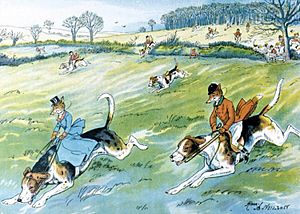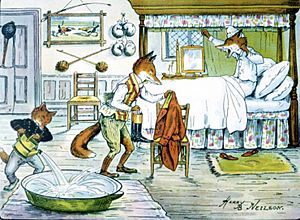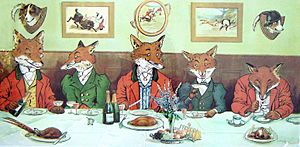Harry B. Neilson facts for kids
Quick facts for kids
Harry B. Neilson
|
|
|---|---|

From The Fox's Frolic (1917)
|
|
| Born | Henry Bingham Neilson 1861 Birkenhead, Cheshire, England |
| Died | 13 October 1941 (aged 80) West Kirby, Cheshire, England |
| Occupation | Children's author and illustrator |
| Nationality | British |
| Genre | Children's literature |
| Notable works | Mr Fox's Hunt Breakfast on Xmas Day (1897) The Fox's Frolic (1917) |
Harry B. Neilson (born Henry Bingham Neilson, 1861 – 1941) was a talented British artist. He is best known for illustrating many children's books. His drawings often showed animals dressed as people, doing funny and active things.
Before becoming a famous illustrator, Harry Neilson had an interesting life. He worked as an engineer and electrician. He even spent time in India, where he was a part-time soldier. By the 1890s, he became a full-time artist. He spent his later years living in a quiet English village.
Contents
Early Life and Adventures
Harry Neilson was born in 1861 in Birkenhead, England. This area is called the Wirral Peninsula. His father was a merchant from Scotland, and his mother was born in Colombia. Harry was the youngest of eight children.
When Harry was young, his family moved to a new house called Airliewood. He remembered how people dressed back then. Ladies wore big skirts and fancy shawls. Young men wore unique trousers and hats. Even policemen wore tall top hats! Croquet was a popular outdoor game for ladies.
Becoming an Engineer
In 1879, Harry started training to be an engineer. He worked for Laird Brothers, a big shipbuilding company in Liverpool. After finishing his training in 1884, he became an electrician. He worked on a large ship called the SS Noordland. This ship traveled across the Atlantic Ocean.
Time in India
In 1887, Harry went to British India. He joined his cousin, who managed a farm there. While in India, Harry also joined the Bihar Light Horse. This was a group of part-time soldiers.
His first book with his own illustrations came out in 1889. It was called The Adventures of Sam Pippins, Esq., with the Kilkenny Hunt.
A Career in Illustration
By the 1890s, Harry Neilson was a busy book illustrator. Around 1903, he moved back to England. He lived with his sister in a village called Bidston, in his home area of Wirral. He stayed there for the rest of his life.
Harry illustrated many books for children. He often worked with the writer Sam Hield Hamer. S. H. Hamer was also an editor at Cassell & Co., a publishing company. Neilson also drew pictures for magazines. He designed postcards and Christmas cards too.
Famous Animal Art
Neilson was known for drawing animals dressed like humans. This was a popular style at the time. Other artists like Beatrix Potter also drew animals in this way. But Neilson's animals often seemed more energetic and lively.
One of his most famous works is "Mr Fox's Hunt Breakfast on Xmas Day" (pictured). This picture shows foxes dressed for a hunt. They are eating pheasant and drinking "Renard" (French for fox) champagne. The pictures on the wall show hunting scenes, but with foxes chasing men! This artwork was given away with a newspaper in 1897. It was even featured on the cover of Country Life magazine 100 years later.
Other Notable Works
In 1902, Neilson's book Games and Gambols came out. It included a famous picture of a "great test match between the Lions and the Kangaroos."
He also worked with Irish writer William Boyle. Together, they created two books of funny poems: Comic Capers (1903) and Christmas at the Zoo (1904).
In 1917, Neilson returned to his fox theme. He illustrated The Fox's Frolic; or, A Day with the Topsy Turvy Hunt. This book had a long poem where the usual roles of fox hunting were flipped. Foxes rode hounds and hunted humans!
Harry Neilson loved horses and was a skilled rider. He even took care of his own horse. In 1935, he wrote a book of his own memories called Auld-lang-syne. It shared stories about his life in Birkenhead and Bidston.
Harry B. Neilson passed away on October 13, 1941, at the age of 80. His drawings continue to be enjoyed by many. The University of California, Los Angeles has a collection of his original drawings and writings.
Neilson's Unique Art Style
Harry Neilson's art style was very distinct. He drew cartoons that were lively and sometimes a bit rough. His way of using lines in his drawings has even influenced modern comics.
What made Neilson's art special was how he drew animals. Even when they wore clothes and acted like people, his creatures always looked like real animals. They kept their animal shapes and features, making them both funny and believable. He was a master at telling stories through his animal characters.



